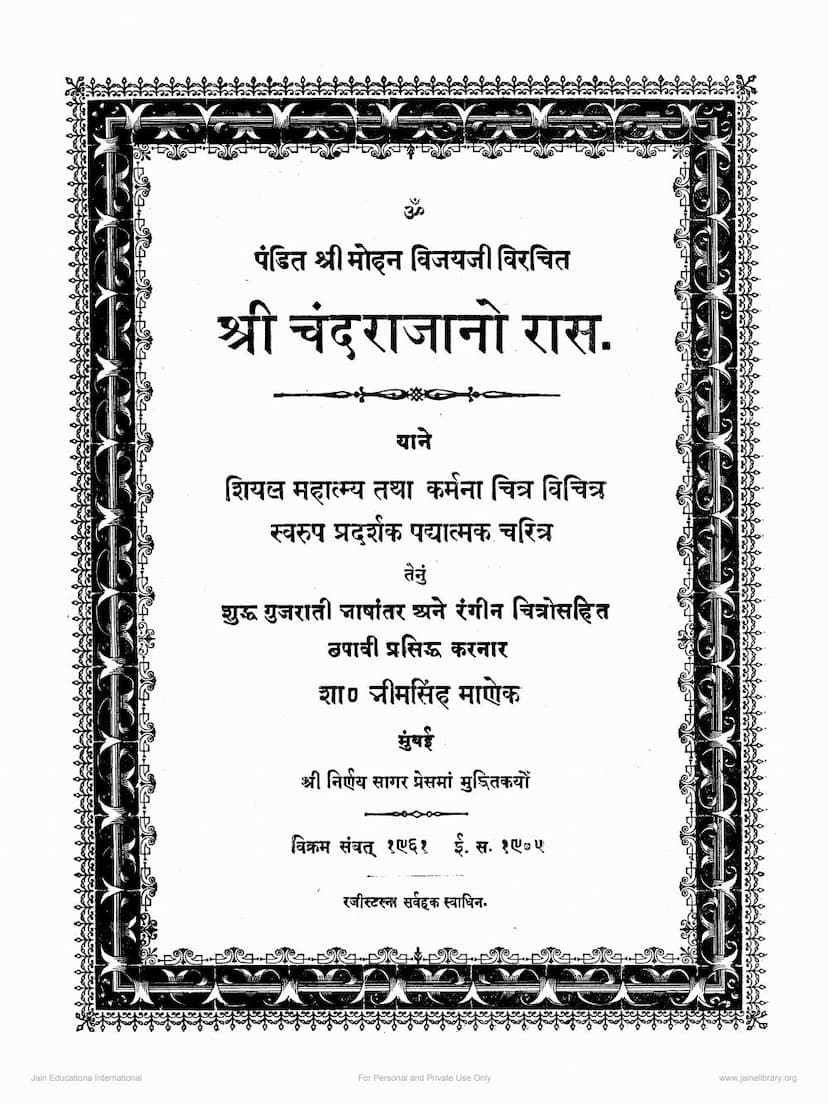Chand Rajano Ras
Added to library: September 1, 2025

Summary
Summary of "Chand Rajano Ras" by Shravak Bhimsinh Manek
"Chand Rajano Ras" is a devotional Jain text authored by Shravak Bhimsinh Manek. The catalog link provided points to a Gujarati version of the text, likely a poetic narrative or "Ras" (a genre of devotional literature often set to music). Based on the provided snippets, the Ras recounts the story of King Chand (or Chandrasingh) and his life, focusing on spiritual themes and his journey towards liberation.
Here's a breakdown of the content from the provided text:
Book Title: श्री चंदराजानो रास (Shri Chandrajano Ras) Author: Shravak Bhimsinh Manek Publisher: Shravak Bhimsinh Manek Year of Publication: Vikram Samvat 2061 (1905 AD) Language: Gujarati (with a mention of a potential simpler Gujarati translation in the introduction)
Overall Theme:
The Ras appears to be a Padyatmak Charitra (poetic life story) that highlights:
- Spiritual Significance: It emphasizes the importance of Brahmacharya (celibacy) and its profound significance within Jainism, suggesting that other philosophies might not grasp its full depth.
- Karma and Liberation: The narrative seems to explore the intricate nature of karma and its influence on a soul's journey, ultimately leading towards liberation (Moksha).
- Virtuous Conduct: It likely details the life of King Chand, showcasing his adherence to Jain principles, his spiritual endeavors, and the unfolding of his destiny in accordance with Jain philosophy.
Content Highlights from the Snippets:
- Introduction (Page 3): The introduction by Pandit Shri Mohan Vijayji praises the Ras for its poetic beauty, profound meaning, and captivating narrative. It mentions the text's focus on the glory of Brahmacharya and the complex nature of karma. It also suggests that the text might have been translated into simpler Gujarati for wider accessibility.
- Table of Contents (Page 5): The index outlines four "Ullhas" (chapters or sections) detailing King Chand's life:
- First Ullhas: Birth of King Chand, renunciation of Veer Sen, Queen Veermati's plot, and deception.
- Second Ullhas: King Chand's encounter with the King of Simhal, Prince Kanakdhvaj's story, King Chand's marriage to Premalali, and their return to Ajayanagari.
- Third Ullhas: Premalali's plight in Vimalpuri, her rescue by Chand, Veermati's curse turning Chand into a peacock, and his offering to the dancer Shivmala.
- Fourth Ullhas: King Chand regaining human form on Mount Vimachal, Veermati's demise, his return to Ajayanagari, acceptance of vows, and attainment of peace.
- Narrative Excerpts (Pages 9-48): The snippets provide glimpses into the narrative:
- Early Life and Setting: Descriptions of Jambudweep, the Jambu tree, and the prosperous city of Ajayanagari, ruled by King Virsen and Queen Veermati.
- King Chand's Character: He is depicted as virtuous and influential.
- Challenges and Transformations: The story involves encounters with foreign princes, curses (like being turned into a peacock), imprisonment, and eventual spiritual realization.
- Key Characters: King Chand, Queen Veermati, Queen Premalali, Prince Kanakdhvaj, Shivmala, Minister Himsak, King Makardhwaj, and the Sage Mohan Vijay (as the narrator/composer).
- Spiritual Journey: The narrative seems to follow a path of trials, understanding of karma, and ultimately, the adoption of asceticism and attainment of spiritual peace. The text emphasizes the concept of karma's pervasive influence.
Overall Impression:
"Chand Rajano Ras" appears to be a rich narrative that uses the life story of King Chand to illustrate Jain ethical and philosophical principles. The poetic style, evident in the excerpts with descriptions of verses and "dhals" (stanzas or songs), aims to convey spiritual lessons in an engaging manner. The story involves supernatural elements like curses and divine interventions, which are common in devotional literature to highlight the consequences of actions and the power of devotion and righteousness.